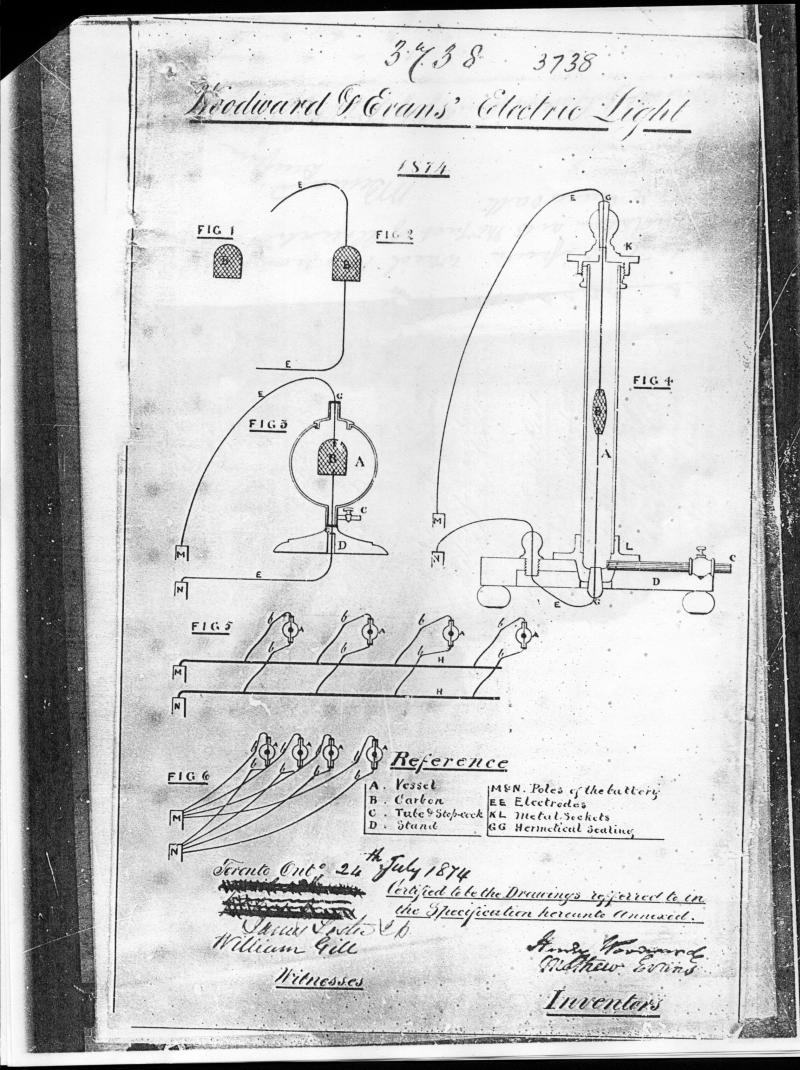This is the text of their handwritten patent submitted in final form to the Patent Branch of the Canadian Department of Agriculture on July 24, 1874 (five years before Thomas Edison's 1879 patent).
I've tried to preserve the exact spelling, capitalization and punctuation.
Places where I couldn't quite make out what was written are
indicated in italics.
To all whom it may concern:
Be it known that We Henry Woodward of the city of Toronto in the County of York, in the Province of Ontario Medical Electrician, and Mathew Evans also of the city of Toronto, in the County of York, in the Province of Ontario Gentleman, have jointly invented
New and useful improvements in the art or process of obtaining Artificial light by means of Electricity and we do hereby declare that the following is a full clear and exact description of the same.
In the first place we use a gas engine, or other suitable motive power, for the purpose of rotating a magneto Electric Machine, and at Such Velocity, as shall create electricity, sufficient to heat certain pieces of Carbon to a state of incandescence.
In the Second place, we use pure Carbon and place the same in lamps, or outer suitable vessels, as hereinafter described.
A piece of Carbon, as hereinbefore mentioned, pure in quality, and of suitable size, proportionate to the size of lamp or vessel to be used, is scraped and shaped until fitted for the purpose. One electrode is then Connected with the Carbon at the top, and the other electrode is connected with the Carbon at the bottom, in the following manner. A small hole is drilled a short distance into each end of the Carbon to fit the electrodes, and when necessary they are further secured by surrounding them with a portion of plaster of Paris or other suitable substance. The electrodes not passing through the carbons, nor Connecting with each other. It is then enclosed in a globe, or other vessel, either of glass or other Suitable material. The air is then extracted from the said globe, or vessel, after it has been hermetically sealed at the ends, and then filled with rarified gas that will not unite chemically with the carbon when hot. Electricity is now supplied and in sufficient quantity, so as to heat the carbon within the vessel to a State of incandesence, the rarified gas previously introduced now becomes luminous, and constitutes the light herein designated as Woodward and Evans' Electric Light.
This process will give a light of any required intensity, and there is practically no limit to the number of lights that may be obtained from one Magneto Electric Machine.
In the accompanying drawings, the same letters of reference indicate the same parts in all the views, and also in the Specification.
Fig 1 - is an Elevation, or front view of a piece of Carbon and is marked B; it is supposed to be scraped and shaped until suitable for the required purpose.
Fig 2 - is also an Elevation, or front view of the same piece of Carbon with the electrodes E E attached thereto, leading to, and from, the positive and negative poles of the battery, one being attached at the top and the other at the bottom of the Carbon.
Fig 3 - is a Sectional Elevation, showing globe marked A, but which may be a vessel of any other suitable form; The prepared Carbon B is also shown herein, and the aforesaid electrodes E E attached thereto. Showing also a tube C with an air-tight stopcock to be used in exhausting the air from the globe or Vessel A, and also for the injection of rarified gas into the same. Showing also the hermetical sealing of said vessel at the ends of the tubes and marked G G; and showing also the stand D.
Fig 4 - is also a Sectional Elevation, showing the adaptation of another form of Vessel A; This drawing is on a larger scale in order to show the manner of closing the ends of the vessel which is done by brass sockets, that at the top being marked K and that at the bottom I. Showing also the Carbon B, different in form than that in the Vessel, and the two electrodes E E, running to and from the Poles M N.
Fig 5 - is an Elevation, Showing one mode of Connecting the various lights with the machine by means of two trunk wires, or electrodes H H running from the positive and negative poles M and N of the machine, with branches b b therefrom to each light.
Fig 6 - is also an Elevation showing another method of connecting the lights with the machine, each light having a distinct wire b, running to each pole of the machine M + N.
Having thus described our invention We claim - The placing of Carbons B in lamps or other suitable vessels A filled with rarified gas, possessing the property of not chemically Combining with the carbon when in a state of incandesence, in Connection with the arrangement of the electrodes E E fixing and? connecting, the Carbon B, substantially as set forth.
|
Henry Woodward
Mathew Evans |
|
Toronto Ontario 24th July, 1874
Signed in presence of unreadable signature William Gill |
This is the specification referred to in the Affidavit of Henry Woodward and of Mathew Evans hereto annexed. Sworn before me this 24th day of July, AD 1874.
Garret Foster (sp?) unreadable (possibly QC)
